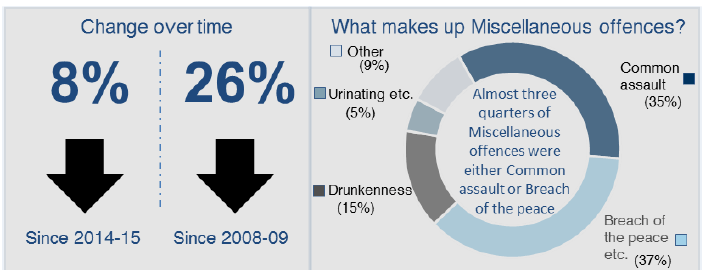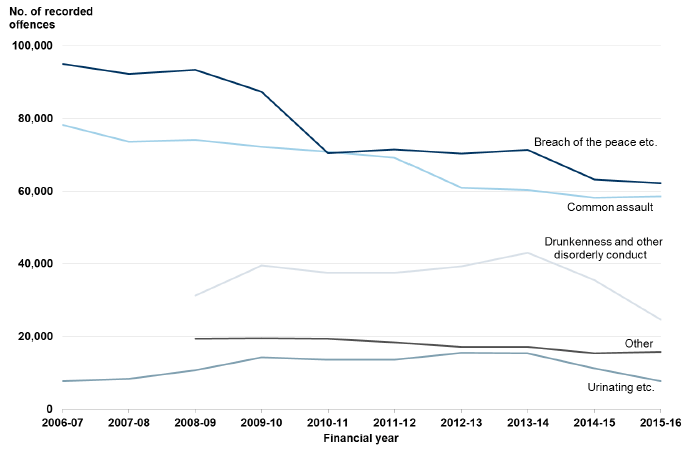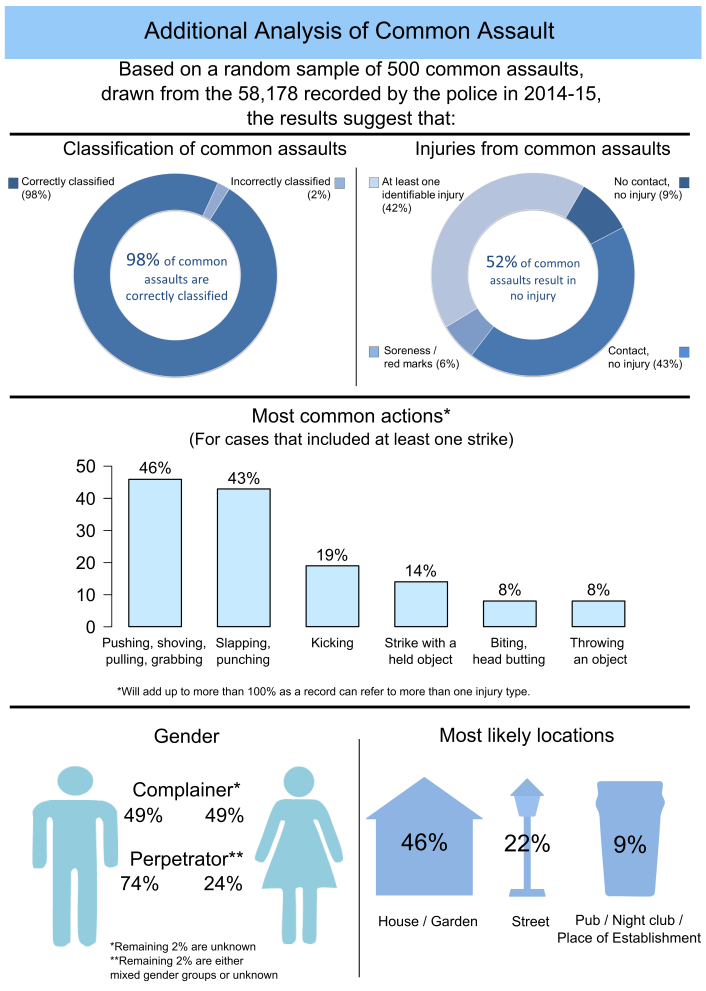Recorded Crime in Scotland, 2015-16
Statistics on crimes and offences recorded and cleared up by the police in Scotland.
Group 6 - Miscellaneous Offences

Number of Miscellaneous offences recorded in 2015-16:
Miscellaneous offences account for half (50%) of all offences recorded in Scotland in 2015-16. Between 2014-15 and 2015-16, the number of Miscellaneous offences recorded by the police in Scotland decreased by 8%, from 183,513 to 168,896.
Due to a number of anomalies in the data for Miscellaneous offences, this group is only comparable from 2008-09 onwards. Further information on the comparability of Group 6 is available in the 'Data Considerations' section below, and in Annex 2.
The national rate of recorded Miscellaneous offences decreased from 343 per 10,000 population in 2014-15 to 314 offences per 10,000 population in 2015-16. This varied by local authority area, with the highest rate in Glasgow City (663 per 10,000 population) and the lowest rate in East Renfrewshire (113 per 10,000 population) ( Table 13).
Chart 17 shows the five categories within Miscellaneous offences over the last ten years, with Drunkenness and other disorderly conduct and Other miscellaneous offences from 2008-09. This chart gives an indication of the trend and scale of each category. Breach of the peace etc. and Common assault have consistently been the biggest contributors to Miscellaneous offences.
Chart 17: Miscellaneous offences in Scotland, 2006-07 to 2015-16

Breach of the peace etc.:
Breach of the peace etc. includes Breach of the peace, Threatening or abusive behaviour, Offence of stalking, Offensive behaviour at football and Threatening communications. A further breakdown of Breach of the peace etc. into its component parts is available in Table A6.
Breach of the peace etc. is the largest category in Miscellaneous offences, accounting for more than a third (37%) in 2015-16. Over the ten year period from 2006-07 to 2015-16, this category has fallen by more than one third (35%), including a 2% decrease from 63,205 in 2014-15 to 62,233 in 2015-16.
All but one local authority area recorded a decrease in this category over the ten year period. Between 2014-15 and 2015-16, more than one half (18) of local authorities showed a decrease.
Common assault:
Common assault accounted for 35% of Miscellaneous offences. Over the ten year period from 2006-07 to 2015-16, this category has fallen by one quarter (25%), including a 1% increase from 58,178 in 2014-15 to 58,596 in 2015-16.
All but one local authority area recorded a decrease in this category over the ten year period. Between 2014-15 and 2015-16, around two thirds (21) of local authorities showed an increase. For the distinction between Common assault and Serious assault please see Paragraph 7.13 within Annex 1.
Scottish Government statisticians reviewed a random sample of 500 common assault crime records from 2014-15 to develop a better understanding of the nature of this type of offence. The analysis of this research is included toward the end of this section.
Drunkenness and other disorderly conduct:
Drunkenness and other disorderly conduct includes offences such as Drunk and Incapable, Disorderly on licensed premises and Consumption of alcohol in designated places, byelaws prohibited. For further information on the classification of crimes and offences, please see Chapter 8.
Drunkenness and other disorderly conduct accounted for 15% of Miscellaneous offences. Despite some fluctuation, levels of this offence fell 21% between 2008-09 and 2015-16. This includes a 31% decrease from 35,524 in 2014-15 to 24,639 in 2015-16.
All but five (27) local authority areas recorded a decrease in this category between 2008-09 and 2015-16. Between 2014-15 and 2015-16 all but five (27) local authorities showed a decrease.
It should be noted that the category Drunkenness and other disorderly conduct is not considered comparable for years prior to 2008-09. This is due to double counting of offences of Disorderly on licensed premises in legacy Tayside, and it has not been possible to correct these data prior to 2008-09. Further information on quality issues is available in the 'Data Considerations' section below, and in Annex 2.
Urinating etc.:
Urinating etc. accounted for 5% of Miscellaneous offences. This category generally increased for several years from 2006-07, peaking in 2012-13. Urinating etc. decreased by 31% from 11,216 in 2014-15 to to 7,700 in 2015-16, the third consecutive decrease in these offences.
Around two thirds (20) of local authority areas recorded a decrease in this category over the ten year period. Between 2014-15 and 2015-16 all but six (26) local authorities showed a decrease.
Other miscellaneous offences
The Other miscellaneous offences category includes a wide range of offences, including Racially aggravated harassment, Racially aggravated conduct, False/hoax calls, Offences invoving children and Offences involving animals/plants. For further information on the classification of crimes and offences, please see Chapter 8.
Other miscellaneous offences account for 9% of Miscellaneous offences. These offences increased by 2% from 15,390 in 2014-15 to 15,728 in 2015-16, in contrast to the general downward trend seen since 2008-09.
Over two thirds (22) of local authority areas recorded a decrease between 2008-09 and 2015-16. Between 2014-15 and 2015-16, around one third (12) of local authorities showed a decrease.
It should be noted that the Other miscellaneous offences category is not considered comparable for years prior to 2008-09. Further information on quality issues is available in the 'Data Considerations' section below, and in Annex 2.
DATA CONSIDERATIONS
As outlined in the overall section on police recorded offences - an extensive data quality exercise was carried out to assess the comparability of data extracted from the Scottish Operational and Management Information System ( ScOMIS) with data collected from legacy police forces and published in previous bulletins. This analysis identified that all data for Group 6, Miscellaneous Offences, are fully comparable from 2008-09 onwards. However, two offences are non-comparable prior to 2008-09: Disorderly on licensed premises (within the Drunkenness and other disorderly conduct category) and Control of Pollution (within the Other miscellaneous offences category). Therefore, comparisons for the Drunkenness and other disorderly conduct and Other miscellaneous offences categories in Group 6 should also only be made for 2008-09 onwards. The comparability of the remaining three categories in Group 6: Common assault; Breach of the peace etc. and Urinating etc. are not affected.
The Scottish Government produced a Technical Report in 2014 which detailed the quality assurance work it carried out in reaching this conclusion: http://www.gov.scot/Topics/Statistics/Browse/Crime-Justice/PubRecordedCrime/TechnicalReport.
DATA VALIDATION
HMICS Crime Audit 2016
It should be noted that in the HMICS audit report, violent crime includes Common assault. Please refer to the Group 1 - Non-sexual crimes of violence section. Further information on this audit, including definitions of terminology and tests used, can be found in Annex 2.
Scottish Government statisticians also reviewed a random sample of 500 common assault crime records from 2014-15 to develop a better understanding of the nature of this type of offence. This research found that the quality of recording decisions for common assault by Police Scotland is very good, with 98% of common assaults classified correctly. The analysis of this research is included in a topical section below.
The previous HMICS Crime Audit, carried out in 2014, included a review of Hate Crime. Of the 504 hate crimes examined, 94% were counted and classified correctly. Five crimes were under-counted and six crimes were over-counted. There were no recurring themes in relation to counting errors for hate crime. However, the majority of classification errors related to the same technical issue around the classification of crimes between s.50(a) (1B) of the Criminal Law Consolidation (Scotland) Act 1005 and s.38 of the Criminal Justice and Licensing (Scotland) Act 2010.
The Test 1 compliance rate of 97% for hate crime was the best of the four crime categories audited in 2014. Test 1 failures tended to relate to a lack of information or update on the incident record to dispel criminality. In several incidents, the complainer became uncooperative but a crime should nonetheless have been recorded. In a few incidents, a crime had clearly taken place but no trace of a crime record could be found.
DATA COMPARISONS
Racially aggravated harassment and conduct
The Other category in Miscellaneous offences contains offences of Racially aggravated harassment and Racially aggravated conduct, and Table A7 shows these offences for the last ten years. In 2015-16 there were 75 offences of Racially aggravated harassment and 2,057 offences of Racially aggravated conduct. While these are specific racially aggravated offences, they do not account for all racially aggravated crimes such as assault or vandalism.
The Racist Incidents Recorded by the Police in Scotland statistical bulletin series contains more detailed information on racist incidents such as victim/complainer and perpetrator characteristics, location of incident and the crimes recorded and cleared up as part of racist incidents.
We therefore recommend that users interested in racist incidents should refer directly to the Racist Incidents Recorded by the Police in Scotland bulletin series, available via the following link: http://www.gov.scot/Topics/Statistics/Browse/Crime-Justice/PubRacistIncidents.
The latest Racist Incidents Recorded by the Police in Scotland bulletin, containing data for 2013-14, was published in November 2015. This bulletin also outlined plans to scope out the possibility of replacing the racist incidents publication with a new and broader statistical product on police recorded Hate Crime. Work will continue with Police Scotland as they consider the Hate Crime data they hold on their existing systems, and users will be informed as this develops.
Scottish Crime and Justice Survey ( SCJS)
In addition to information on police recorded crime, the SCJS provides a complementary outlook on crimes of violence through asking respondents about their experiences.
As previously noted, violent crime as defined by the SCJS is not directly comparable with non-sexual crimes of violence recorded by the Police. Common assaults, which make up the majority of SCJS violent crime, are included in the Miscellaneous offences police recorded crime group, and the Non-sexual crimes of violence crime group includes homicide.
A more detailed examination of comparisons between the SCJS and recorded crime is made within Chapter 5.
Key points from the Scottish Crime and Justice Survey:
As stated under the Non-sexual crimes of violence section, of the 688,000 crimes measured by the SCJS in 2014-15, 186,000 (27%) were violent crimes and it is estimated that 2.6% of adults in Scotland were a victim of violent crime in 2014-15.
In 2014-15, minor assaults made up the vast majority of SCJS violent crime (76%), followed by attempted assault (16%), serious assault (4%) and robbery (4%).
Further detail on the comparable crime set is available in Section 5.3. As outlined there and in the Annex of the 2014-15 SCJS, violent crime in the SCJS includes assault and robbery, crimes which are included in Group 1 (Non-sexual crimes of violence) and Group 6 (Miscellaneous offences) in police recorded crime figures.
As outlined in Section 5.3, recorded violent crime figures in the comparable category decreased by 24% between 2008-09 and 2014-15, while for the same period the SCJS estimates of violent crime decreased by 41% (a statistically significant change in the SCJS results).
Group 6 - Miscellaneous Offences: An Additional Analysis of Common Assault Offences
This topical section of the Bulletin presents some additional analysis of police recorded common assault. In December 2015 the Scottish Crime Recording Board commissioned research into the nature of violence contained within police recorded common assault. The purpose of this research was to inform the Board's ongoing consideration of how crimes and offences are grouped together in the presentation of these statistics.
Scottish Government statisticians reviewed a random sample of 500 common assault crime records, which represented 0.9% of the 58,178 recorded by the police in 2014-15. Statisticians assessed whether each sampled record met the definition of a common assault and information was captured on the characteristics of each case. As this research is based on a sample of police records, users should treat the following analysis as a broad indication of the characteristics of common assault, rather than as an exact measure. All figures are presented at Scotland level as sample sizes are too small to provide robust estimates for geographies below this. A summary of the research findings is provided below and in the infographic.
Quality of Recording Decisions:
The quality of recording decisions for common assault by Police Scotland is very good. 98% of common assaults were classified correctly. Those records incorrectly classified as common assault were either a breach of the peace, a serious assault or insufficient detail was provided to dispel the notion a serious assault had occurred.
Action of the Perpetrator(s):
In only 2% of cases were the actions of the perpetrator(s) considered to be no worse than spitting or insufficient to classify the case as an assault. The remaining 98% of cases split almost equally into single strikes against the complainer (49% of all records sampled) or at least two strikes against the complainer (48% of all records sampled).
For those cases that included at least one strike against the complainer, the most common action was pushing, shoving, pulling or grabbing (46% of cases), followed by slapping or punching (43%), kicking (19%), striking with a held object (14%), throwing an object (8%) and biting or head butting (8%). These figures add up to more than 100% as assault can have multiple action types.
Injuries sustained by the Complainer:
Around half of common assault cases involve no or very little injury to the complainer (victim). These include:
- Incidents with no contact between the complainer and perpetrator(s), either because the attempted strike by the perpetrator(s) missed the complainer or the perpetrator(s) spat on the complainer (9% of cases),
- Incidents with confirmed contact between the complainer and perpetrator(s), but the record either reports no or very little injury to the complainer or no mention is made of any injuries (43% of cases).
The remaining common assault cases (again around half) involve some degree of injury to the complainer. These include:
- Injuries of soreness and/or red marks on skin only (6% of cases),
- The confirmation of single or multiple injuries to the complainer beyond soreness and/or red marks on the skin (42% of cases). This includes the small number of cases the research determined should have been recorded as serious assaults.
Where the complainer had sustained at least one injury during the assault, the most frequently referred to injuries were scratches, lacerations and/or the drawing of blood (51% of cases), followed by bruising and/or swelling (42%), soreness and/or red marks (26%) and other injury types (15%). These figures add up to more than 100% as an assault can have multiple injury types.
Almost three-quarters (72%) of those records that note some kind of injury place at least some of those injuries around the head and neck area of the complainer.
Characteristics of the Complainer and Perpetrator(s):
Complainer gender split equally between male and female (49% in each case - with the remaining 2% unknown). Perpetrators were much more likely to be male or all male groups (74% of cases).
A majority (61%) of common assault cases occur between people who know each other - including partners or ex-partners (29% of cases reviewed), acquaintances (23%) and family members who are not partners (9%). Females were more likely to be assaulted by a partner or ex-partner than males (46% of assault with a female complainer involved a partner or ex-partner as perpetrator, compared to 14% of assault with a male complainer).
Around a third (34%) of common assault cases occur between people who do not know each other - including cases where the complainer was undertaking an occupation that may have increased their risk of being assaulted (i.e. Police officer, security staff etc.) (17% of cases reviewed) and cases where the complainer wasn't undertaking an occupation with increased risk (also 17%). The remaining 5% of all cases sampled had an unknown relationship status.
The most likely location for a common assault was a dwelling house or garden (46% of cases). This was followed by the street (22%), and pubs/night clubs/ places of public establishment (9%).
Around half (49%) of common assault records make reference to the consumption of alcohol. This could be by the perpetrator(s), the complainer or both. This doesn't necessarily mean that alcohol was a factor in every one of these assault cases. At the same time alcohol may have been consumed prior to some of the other assaults, but not referenced in the crime record. Six per cent of records sampled make reference to the consumption of drugs, though the same caveats as noted above for alcohol apply.
Next Steps:
The Scottish Crime Recording Board will reflect on the findings of this research and any impact this may have on how crimes and offences are grouped together for statistical purposes. This will be undertaken in tandem with the Board's consideration of HMICS's Crime Audit 2016 publication (which assessed the extent to which police recording practices complied with the Scottish Crime Recording Standard and counting rules - see a summary of the Audit's findings above).
Going forward, the Board will also consider whether further sampling of police records could increase the value of these statistics (through gaining new information on the characteristics of police recorded crimes and offences) and what resources may be available to support this work. Users will be kept informed as this work develops and can register for updates on crime statistics through the Scotstat network: http://www.gov.scot/Topics/Statistics/scotstat.

Contact
There is a problem
Thanks for your feedback